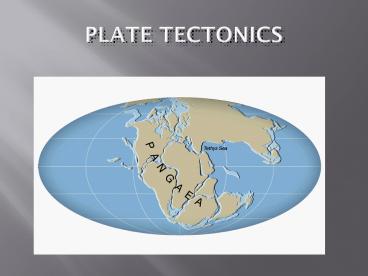PLATE TECTONICS - PowerPoint PPT Presentation
1 / 17
Title:
PLATE TECTONICS
Description:
CONVECTION CURRENTS:-Hot magma from the mantle rises, cools, + sinks.-Mantle moves + drags plates along with it. – PowerPoint PPT presentation
Number of Views:88
Avg rating:3.0/5.0
Title: PLATE TECTONICS
1
PLATE TECTONICS
2
WHY?
- Alfred Wegener
- Noticed similarities in the shoreline of
continent on both sides of the Atlantic Ocean, he
then began fitting them together. - Introduced the hypothesis of continental drift.
- Suggested a supercontinent, called Pangaea
(meaning "all land"), that broke up millions of
years ago, slowly moved to their current
positions, and continue to move today.
3
LITHOSPHERE / ASTHENSPHERE
4
CONVECTION CURRENTS-Hot magma from the mantle
rises, cools, sinks.-Mantle moves drags
plates along with it.
5
PLATES
6
DIVERGENT
- DIVERGENT- When two plates move away from each
other. - Characteristics
- Mid ocean ridges (underwater mountain ranges)
- Rift Valleys (narrow valleys that form where
plates separate), Newest rock material (cooling
magma forms new oceanic crust).
7
DIVERGENTEx Seafloor Spreading
8
CONVERGENT
- CONVERGENT When two plates collide.
- Characteristics Mountains, most earthquakes,
Volcanoes, and trenches - 1.ocean ocean 2.ocean continent 3.continent
continent
9
OCEAN OCEAN CONVERGENT BOUNDARY Subduction
Zone Mantle rock melts magma rises to the
surface, creating islands.
10
OCEAN CONTINENT CONVERGENT BOUNDARY Subduction
ZoneOceanic Crust is more dense sinks under
Continental Crust
11
CONTINENT CONTINENT CONVERGENT BOUNDARY
Plates collide the edges crumple, causing
uplift mountains
12
TRANSFORM BOUNDARY
- TRANSFORM When two plates are moving past each
other. - Characteristics San Andreas Boundary
13
Ex SAN ANDREAS BOUNDARY
The Pacific plate and North American plate grind
past each other side by side.
14
REVIEW
15
HOT SPOTS
AREA WITHIN A PLATE WHERE MAGMA WORKS ITSELF TO
THE SURFACE ARE CALLED HOT SPOTS. HOT SPOTS ARE
STATIONARY SO WHEN THE PLATE ABOVE IT MOVES A NEW
VOLCANOE FORMS.
16
(No Transcript)
17
(No Transcript)































